The Acer Swift 3 SF314 Notebook Review: Swift Gets Swifter With Ryzen 4000
by Brett Howse & Andrei Frumusanu on May 5, 2020 8:00 AM ESTWireless
Acer has fitted the Intel AX200 Wireless adapter in their Swift 3, and for good reason. Intel’s wireless networking adapters have been the cream of the crop in the PC space for some time, with rock solid stability, and excellent performance. The AX200 is the new Wi-Fi 6 adapter, adding 160 MHz channel support and higher QAM orders to provide much higher peak performance than Wi-Fi 5, while at the same time offering better congestion control as well.
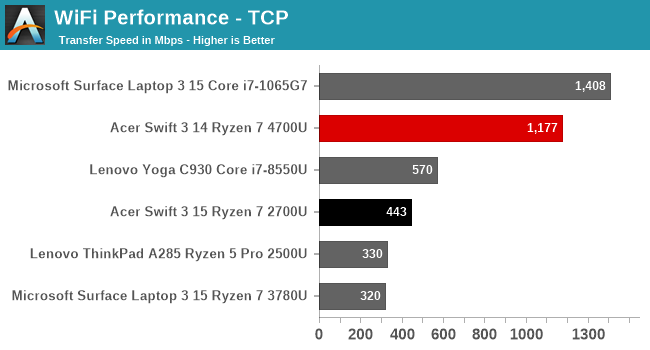
The Acer Swift 3 has very good networking performance from the 2x2 networking solution, hitting over 1.1 Gbps transfer speeds on our TCP test. We are using the ASUS ROG Rapture GT-AX11000 router, and if you’d like to check out more about the new Wi-Fi 6 testing, please check out our overview.
Audio
The Acer Swift 3 features DTS Audio with stereo front-facing speakers, and dual-microphones for Cortana support. Although the speakers are forward facing, they are on the bottom of the notebook, so can be obstructed depending on the surface the notebook is on.
Sound quality is quite good, with reasonable bottom end response for a notebook of this size. The speakers do not get overly loud, measuring 75 dB(A) one inch over the trackpad, but the sound was free from distortion.
Thermals
Thin, light, and performance. The holy trinity of laptop design. It is not always easy to achieve. Acer has a thin and light laptop, with a new 7 nm AMD Ryzen 7 4700U onboard which should help them out, but to see how the laptop responded it was run through an extended stress test of the CPU, with the GPU kicked in near the end.
As with most modern CPUs, the Ryzen 7 quickly ramps up well past its target thermal design power, hitting around 30 Watts draw at the start, but as the test goes on, that value falls back to around 18 Watts. But the power line shows several spots where it dropped back due to thermal capacity. A perfect result here would be a straight line for the CPU frequency but struggles to maintain its boosted frequency. The laptop does not seem to find a sweet spot where it can maintain temperatures either, it instead bounces from maximum power draw to minimum. The GPU also is not consistent when it is turned on around the 2300 second mark.
As this is a full stress test, it can be unfair since you are unlikely to run into a scenario where you use the system at 100% load for such an extended duration. To see how the laptop performs in a more real-world test, it was again tested using Far Cry 5 as a load source.
If anything, the results were even more disappointing. The laptop really struggled with its thermals, dropping the framerate into single digits often. The device attempted to run at around 18 Watts of power draw, slightly over the 15 Watt TDP, but in fact only averaged around 8 Watts during this run.
The laptop does not get overly loud during this load, only hitting around 45 dB(A), but clearly the included cooling system is inadequate for very heavy loads, such as gaming. Far Cry 5 is a demanding game, especially on CPU, so the SoC is even more taxed trying to balance the CPU and GPU, but overall this is a very poor result.
Software
Acer includes a few utilities which are useful, and a few that are not, such as some Norton Antivirus with a short trial period. But it is worth looking at a few pieces of software and included utilities.
The AMD Radeon Settings gives you control over the GPU settings, including disabling Vari-Bright, and seeing the system settings. It is a nice looking utility, but other than providing a few options to enable or disable, but it would be nice if you could use it to manage driver updates for the GPU rather than just copy the version numbers.
If you do want to update drivers, you can use the Acer Care Center, where you can also manage recovery media creation and support requests. This is now a standard feature on all notebooks, and Acer’s implementation is attractive and easy to use.
Acer includes a couple of links to e-tailers like Amazon and Booking.com, which are easily deleted, but also are a quick reminder that margins are thin when prices are this low.


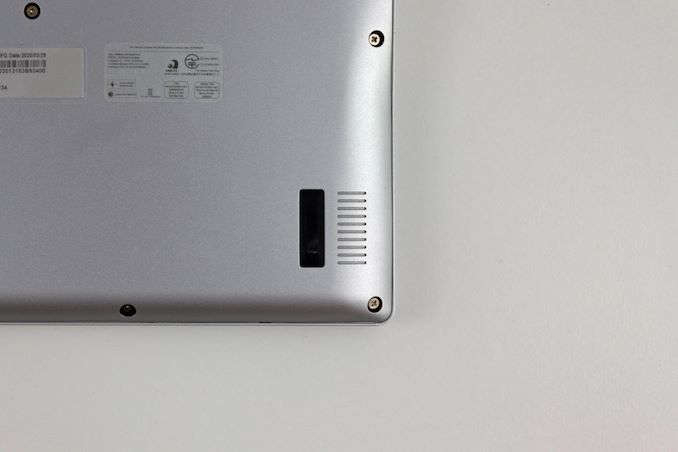
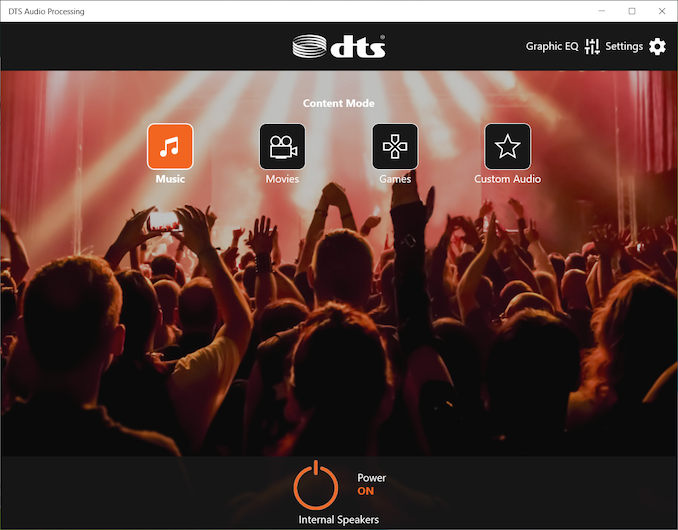
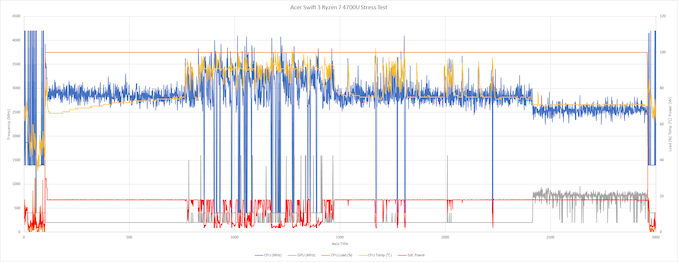
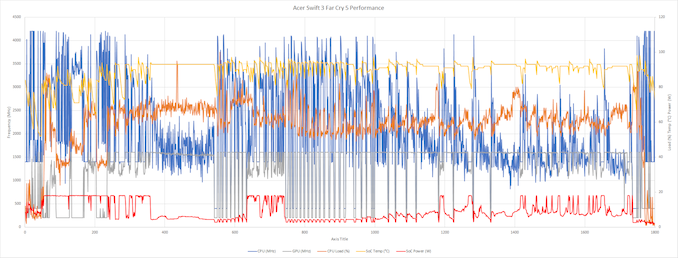
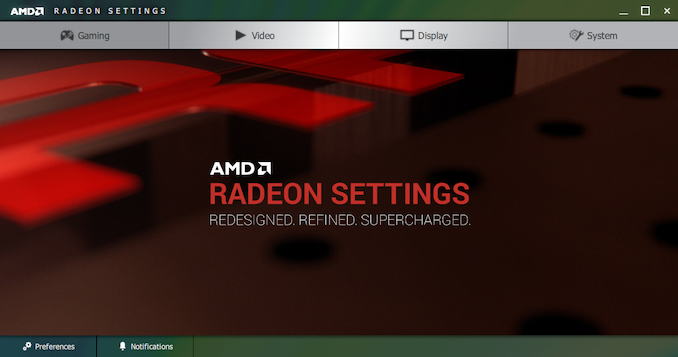

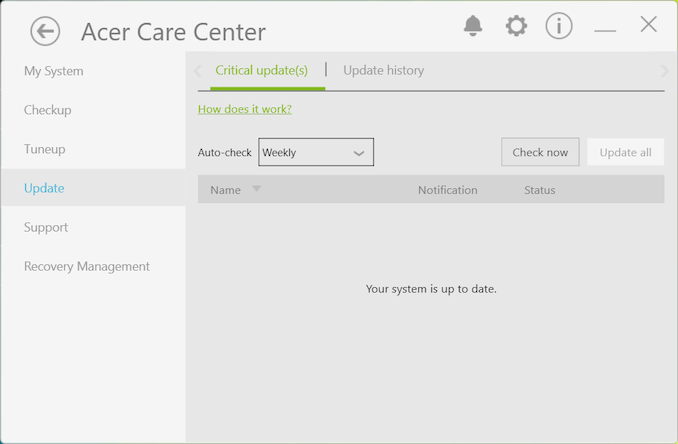








191 Comments
View All Comments
Samus - Tuesday, May 5, 2020 - link
Wow.watzupken - Tuesday, May 5, 2020 - link
Not sure if anyone pointed out as a feedback, but the legend and the numbers on the axis on the thermal related graphs are too small to see.Anyway, I actually don't find it surprising the performance is once again held back by poor cooling. Considering this is a 1.2KG 14 inch laptop, it should not come across as surprising. We need to consider the fact that this is a proper 8 core processor with a fast GPU. While light is good, but I feel we have gone passed a reasonable/ sensible pushed for slimmer and ligher laptops. Slimmer/ lighter generally means compromising on battery, and/or, cooling.
Brett Howse - Wednesday, May 6, 2020 - link
You can click on the image to get a full-sized version of the thermal graphswatzupken - Wednesday, May 6, 2020 - link
Yeah, I figured out later, but unable to amend my post. Perhaps you folks should consider putting in an edit button here.neblogai - Wednesday, May 6, 2020 - link
There may be an issue with the sample Anandtech got. Cooling is generally praised in other reviews of the same laptop, it does not go over 70C at sustained loads (18W). Also, here is FarCry5 running perfectly fine of Swift3 (4500U, but same at the same 18W): https://youtu.be/TvVaJ5jlgsQHowever, if you look at the graphs Anandtech posted- especially the first graph is telling: at 18W, temps go up slowly from ~65C to ~70C, but then suddenly jump to ~95C, with a hard throttle as a result. Something is failing in their unit, a properly functioning cooling would not be behaving like this.
SkillTim - Wednesday, May 6, 2020 - link
Can someone explain:According to Wikipedia, the 4700U iGPU gives 1433.6 GFLOPS raw performance and the 3780U iGPU gives 1971.2 GFLOPS. Why does this review seem to give the 4700U the win every time in real world performance? Is the review selective? Is Wikipedia wrong? Is the CPU/GPU I/O better in Zen 2?
neblogai - Wednesday, May 6, 2020 - link
1. TFPLOPs is just one paramether- Renoir has higher bandwidth, 2x IF width with iGPU, higher Pixel rate, etc.2. Those Picasso TFLOPs in Wiki, and in AMD slides, are theoretical/marketing speeds, not real life ones. Picasso can not run games at that clock/those TFLOPs, as there is not enough power for it. While Renoir/ is mostly able to keep it's boost/TFLOPs (at least in CPU/light games).
Peskarik - Wednesday, May 6, 2020 - link
Good monitor and bigger battery for 100g more weight and 300 more cost would be welcomed.watzupken - Wednesday, May 6, 2020 - link
If you are looking for better monitor and longer battery life, I think you will need to move up to the Swift 5 series. I observed that Acer have been using very dim monitors (250 nits or lower) on their Swift 3 series for a number of years now and I doubt they will give you a better option to maintain the product segmentation.Peskarik - Wednesday, May 6, 2020 - link
thanks, watzupken